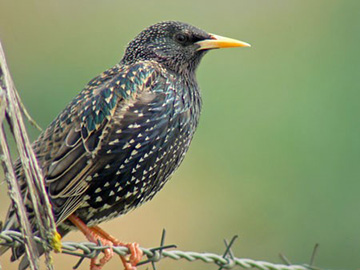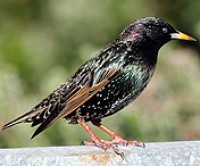This year’s extended summer drought, has had an unusual effect on Sanctuary Lake’s bird visitors. In early autumn we normally welcome large flocks of Galahs who take over the median strips, roundabouts and fairways in their hunt for insects. But this year only a small number, a couple of family sized flocks, no more than twenty, appear to have arrived. They seem to have been replaced or displaced by the Common Starling, who have taken in large numbers, to foraging amongst our Estate’s multitude of short cropped grasses for every type of insect, from spiders to flies
The Common Starling (Sturnus Vulgaris) is an introduced species. The early settlers in Victoria cleared the bush but found their newly planted crops were being invaded by hordes of caterpillars and other insects. Native birds were not habituated to living in close proximity to humans so it was decided to introduce the Common Starling from Europe to consume the insect pests destroying the new farm crops. The first Starlings arrived in Melbourne in 1857. Early settlers looked forward to their arrival, believing that Common Starlings were also important for the pollination of flax, a major agricultural product at that time. Nest-boxes for the newly released birds were placed on farms and near crops. By the 1880s, established populations were present in the southeast of the country thanks mainly to the work of acclimatisation committees. By the 1920s, with very few predators, the Common Starlings were quickly becoming widespread throughout Victoria, but by then, they were also starting to be considered pests..

Common Starling Sturnus Vulgaris in its autumn and winter colours

Common Starling in breeding colours, yellow beak and pink legs
Starlings are small to medium-sized birds with males and females similar in appearance. They have distinctive glossy black feathers with an iridescent green and purple sheen. From a distance they give a look of shiny black. At this time of year, after moulting the new feathers grow with pale tips, giving the birds a distinctive spotted appearance. However, by November these tips have worn and the birds appear glossy black again. The beak is blackish in colour for most of the year, but yellow while the birds are breeding. Young birds (arriving spring and summer) are a dull mouse-brown colour and when they moult to adult plumage in autumn, they have a patchy brown and black appearance, often with some pale spotting.
Starlings are aggressive, social birds and can form very large flocks that move, feed and roost together. On the ground, they walk jauntily or run, rather than hop like many other birds.
Starlings can breed across a wide range of habitats. In Victoria they breed from September through to December and can have up to three broods per year. Nests are built in any available cavity often in tree hollows or buildings. The nests are constructed of dry grass combined with assorted other material, including twigs, leaves and feathers. Four to five light-blue eggs are laid, which hatch after 13 days. The young remain in the nest until three weeks of age.
Common Starlings have a varied diet that includes insects, spiders, seeds, grains, fruit, livestock feed and food waste. To breed successfully they need to eat insects but plant food is also readily consumed.
Starlings feed mainly on the ground where they pick up food items off the surface as well as probe into the soil with their strong beaks. They also pick food items off vegetation, catch flying insects and pluck whole or pieces of fruit from trees and vines. They prefer short grass when foraging and the well-maintained gardens of Sanctuary Lakes and its golf course provide ideal feeding sites.
In Victoria and especially in rural areas, the Common Starlings have become a major pest. They can cause significant damage to horticultural industries, particularly fruits and a range of vegetable crops. Cereal crops are susceptible when grain is freshly sown and during ripening. They can also carry many parasites and diseases which raise concern in food factories and industrial areas and are a potential risk to livestock industries. Environmental impacts centre round their aggressive competition for nest hollows which is potentially serious for some native species such as Cockatoos.
Starlings are also considered to be a major nuisance in urban areas. They will nest under roofs where they can infest houses with bird lice, are often unwelcome in parks and shopping areas, especially at night where the roosting flocks can be unsightly, noisy and able to contaminate the area with droppings. The Starling has been included in the IUCN List of the world's 100 worst invasive species.
Fortunately for Sanctuary Lakes they have not, as yet, started either nesting or roosting in large numbers and are mainly daytime visitors. Although recently I have seen a flock of Rosellas fighting with the Starlings over a large Tree in Andrews Square by Lakeside Drive.
Presently the Starling are a positive and helpfully balance Sanctuary Lakes natural growth, but it would be prudent for residents to watch out for signs of major increase in flocks. There are numerous non-lethal techniques, such as using auditory devices, which can quickly upset and scare the Starlings from settling, nesting and roosting.
Finally, classical Starling trivia: Mozart had a pet Common Starling which could sing part of his G Major Piano Concerto He bought it from a shop after hearing it sing a phrase from a work he wrote six weeks previously, which had not yet been performed in public. He became very attached to the bird and arranged an elaborate funeral for it when it died three years later. So, if you are wondering along the Southern Boulevard and hear from out of the grassy strips, a Common Starling whistling the opening phrase to” Eine Kleiner Nachtmusik” you will know without a doubt, his ancestor’s lineage.